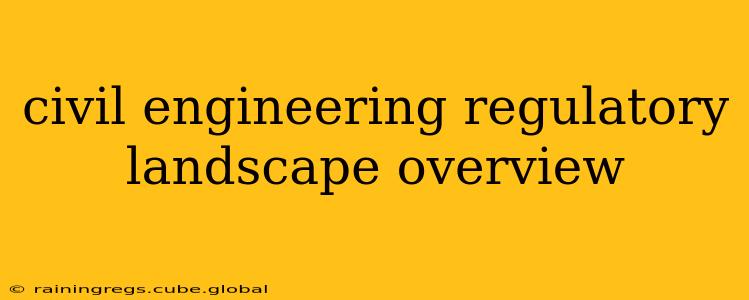Civil engineering, a field responsible for shaping our built environment, operates within a complex and often multifaceted regulatory landscape. Understanding these regulations is crucial for engineers, contractors, and anyone involved in infrastructure development to ensure projects are safe, sustainable, and compliant. This overview delves into the key aspects of this regulatory environment, exploring its nuances and challenges.
What are the main regulatory bodies for civil engineering?
The regulatory bodies overseeing civil engineering vary significantly depending on geographical location. At the national level, many countries have ministries or departments of infrastructure, transportation, or public works responsible for setting overarching standards and guidelines. For example, the U.S. has various federal agencies like the Federal Highway Administration (FHWA) and the Federal Aviation Administration (FAA), each regulating specific aspects of infrastructure. Similarly, the UK has the Department for Transport and Highways England. At a state or regional level, further regulations and licensing boards exist, often responsible for professional engineering licensing and ethical conduct. Locally, municipalities and counties may also impose specific building codes and zoning regulations. International organizations like the International Organization for Standardization (ISO) also play a role by establishing globally recognized standards.
How does the regulatory landscape affect civil engineering projects?
The regulatory landscape profoundly impacts civil engineering projects throughout their lifecycle, from initial planning and design to construction and eventual decommissioning. Regulations dictate design standards, material specifications, environmental impact assessments, safety procedures, and permitting processes. Failure to comply can result in project delays, cost overruns, legal challenges, and even project cancellation. Furthermore, the regulatory environment influences project funding opportunities, as compliance often becomes a prerequisite for securing grants or loans. The complexities of navigating multiple regulatory bodies at different levels can significantly add to project timelines and administrative burdens.
What are the key regulations affecting civil engineering?
Key regulations frequently encountered in civil engineering include building codes (like the International Building Code – IBC in the US), environmental regulations (such as the Clean Water Act in the US or the EU's Water Framework Directive), occupational safety and health regulations (OSHA in the US), and transportation regulations (set by relevant federal, state, and local authorities). Specific project requirements can also necessitate adherence to more specialized regulations related to seismic design, flood control, or hazardous materials handling. The specifics vary dramatically depending on the project's nature, location, and scale.
What are the common challenges faced in navigating civil engineering regulations?
Navigating the regulatory landscape presents several recurring challenges. The sheer volume and complexity of regulations can be daunting, requiring specialized expertise to interpret and apply them correctly. Inconsistencies or conflicts between different regulations at various levels of government can also create significant hurdles. Furthermore, the regulatory environment is dynamic, with frequent updates and amendments requiring continuous monitoring and adaptation. Finally, securing necessary permits and approvals can be a time-consuming and resource-intensive process, often involving multiple stakeholders and bureaucratic procedures.
What are some resources for staying updated on civil engineering regulations?
Staying current on evolving regulations is crucial. Professional engineering societies like ASCE (American Society of Civil Engineers) and ICE (Institution of Civil Engineers) often provide resources, updates, and training on relevant regulations. Government websites at national, regional, and local levels are primary sources for accessing specific regulations and guidelines. Specialized legal and consulting firms also offer expertise in navigating the complex regulatory framework. Regular attendance at industry conferences and workshops can also enhance knowledge and provide networking opportunities.
This overview provides a general understanding of the civil engineering regulatory landscape. The specific requirements and challenges vary considerably based on geographical location, project type, and scale. It is imperative to conduct thorough research and seek expert advice when engaging in any civil engineering project to ensure full compliance with all applicable regulations.
